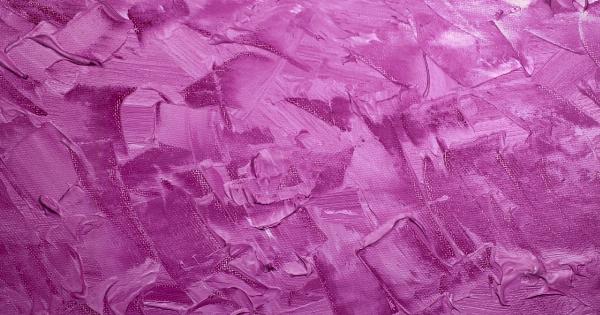Raynaud’s disorder, also known as Raynaud’s phenomenon, is a medical condition that affects blood flow to certain parts of the body, particularly the fingers and toes.
It is characterized by episodes of reduced blood flow, leading to discoloration of the affected areas and a sensation of coldness or numbness.
Causes of Raynaud’s disorder
The exact cause of Raynaud’s disorder is still unknown, but it is believed to be a result of an overreaction of the blood vessels to cold temperatures or emotional stress.
In response to these triggers, the blood vessels in the fingers and toes constrict, limiting blood flow to these areas.
There are two types of Raynaud’s disorder:.
1. Primary Raynaud’s disorder
Primary Raynaud’s disorder, also known as Raynaud’s disease, occurs on its own and is not associated with any underlying medical condition. It is more common and generally less severe than secondary Raynaud’s disorder.
2. Secondary Raynaud’s disorder
Secondary Raynaud’s disorder is usually associated with an underlying medical condition such as autoimmune diseases, connective tissue disorders, or injuries.
This form of Raynaud’s disorder tends to be more severe and requires medical attention to address the underlying cause.
Symptoms of Raynaud’s disorder
The primary symptom of Raynaud’s disorder is the intermittent discoloration of the affected areas.
During an episode, the fingers and toes may turn white (pallor) as blood flow is reduced, then blue or purple (cyanosis) due to lack of oxygen, and finally red (rubor) as blood flow returns.
In addition to discoloration, individuals with Raynaud’s disorder may experience:.
1. Coldness and numbness
The affected areas, particularly the fingers and toes, may feel extremely cold to the touch. Numbness and tingling sensations are also common during episodes of reduced blood flow.
2. Pain and discomfort
Some individuals may experience pain or throbbing sensations in the affected areas. This pain can range from mild discomfort to more severe, causing significant distress.
3. Skin changes
Over time, individuals with Raynaud’s disorder may notice changes in the texture of their skin. The affected areas may become thinner, develop small ulcers or sores, and in rare cases, lead to tissue death (gangrene).
Diagnosing Raynaud’s disorder
Raynaud’s disorder is primarily diagnosed based on the patient’s symptoms and medical history. A physical examination may also be conducted to assess the extent of blood flow disruption and to rule out other possible causes.
In some cases, additional tests may be recommended to determine the underlying cause of secondary Raynaud’s disorder.
These tests can include blood tests, imaging studies, and capillaroscopy, which examines the tiny blood vessels under a microscope.
Treatment options for Raynaud’s disorder
While there is no cure for Raynaud’s disorder, several treatment options are available to manage the symptoms and reduce the frequency and severity of episodes. These treatment options include:.
1. Lifestyle modifications
Simple lifestyle changes can greatly help individuals with Raynaud’s disorder.
Avoiding exposure to cold temperatures, wearing warm clothing and gloves, and regular exercise can all improve blood circulation and reduce the risk of triggering an episode.
2. Medications
In certain cases, medications may be prescribed to help relax and widen blood vessels, improving blood flow. These medications may include calcium channel blockers, alpha-blockers, and vasodilators.
3. Biofeedback therapy
Biofeedback therapy involves learning techniques to control body temperature and circulation using relaxation exercises and mental visualization. This therapy aims to reduce the frequency and intensity of Raynaud’s episodes.
4. Surgery
In severe cases of Raynaud’s disorder, surgical options such as sympathectomy may be considered. This procedure involves cutting or blocking the nerves that constrict blood vessels, helping to improve blood flow to the affected areas.
Complications associated with Raynaud’s disorder
Although Raynaud’s disorder itself is not life-threatening, it can lead to certain complications:.
1. Skin sores and ulcers
Severe episodes of reduced blood flow can cause skin sores and ulcers, particularly on the fingertips. If left untreated, these sores may become infected and difficult to heal.
2. Tissue loss
In rare cases, prolonged and severe episodes of reduced blood flow can result in tissue death (gangrene). This condition may require surgical intervention, such as amputation, to prevent further complications.
Preventing and managing Raynaud’s disorder
While Raynaud’s disorder cannot be completely prevented, certain measures can help manage the condition and reduce the frequency and severity of episodes:.
1. Stay warm
Avoid exposing the affected areas to cold temperatures whenever possible. Wear warm clothing, including gloves and socks, and use hand warmers or heated blankets to maintain body temperature.
2. Stress management
Learn stress management techniques such as deep breathing exercises, meditation, or yoga. Stress can trigger Raynaud’s episodes, so managing stress levels is essential to reduce the frequency of flare-ups.
3. Regular exercise
Engage in regular physical activity to improve overall circulation. Exercise helps keep blood vessels healthy and can reduce the severity of Raynaud’s episodes.
4. Avoid triggers
Identify and avoid triggers that commonly cause Raynaud’s episodes. These triggers may include exposure to cold temperatures, emotional stress, smoking, and certain medications.





























